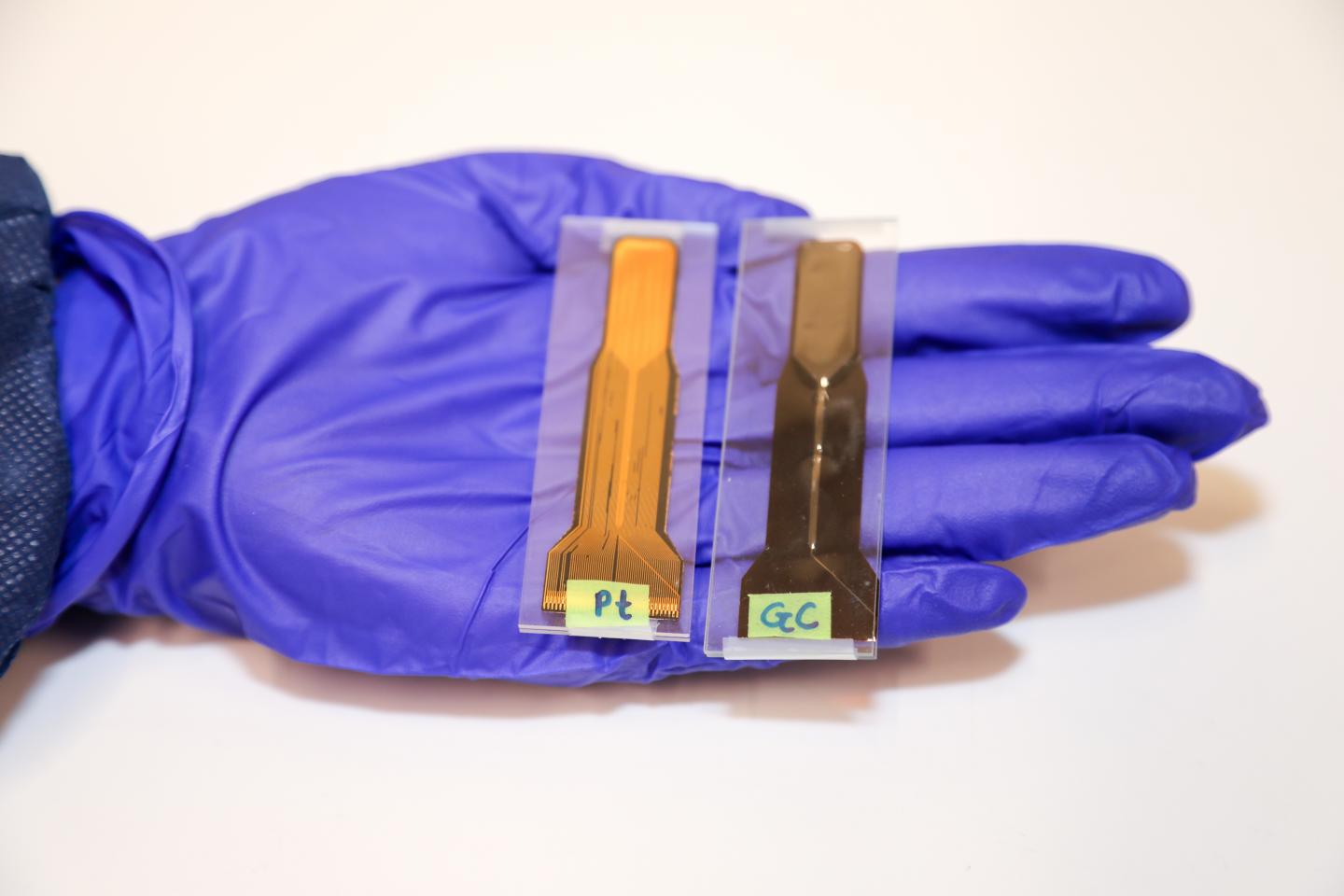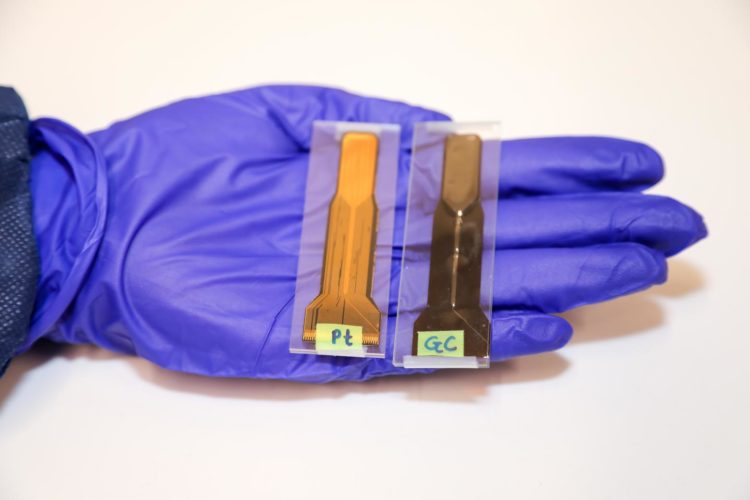Brain-computer interface advancements

Credit: SDSU
Imagine having an electrode embedded in your brain in a surgical procedure that involves drilling holes in your skull to implant it. Now imagine going through an MRI scan for medical evaluation, when the metal electrode may react to the magnetic fields and vibrate, generate heat or even possibly damage the brain.
This is a reality that patients who need deep brain stimulation could face.
Now, a study published Nov. 18 in Nature Microsystems & Nanoengineering describes a promising improvement to the procedure developed by San Diego State University engineers, in collaboration with researchers at KIT, Germany. The SDSU research team created a glassy carbon electrode as an alternative to the metal version, and new findings show it does not react to MRI scans, making it safer.
First developed in 2017 in researcher Sam Kassegne’s MEMS lab at SDSU, the carbon version is designed to last longer in the brain without getting corroded or deteriorated, and to emit and receive stronger signals. In 2018, the researchers showed that while the metal electrode degrades after 100 million cycles of electrical impulses applied to it, the glassy carbon material survived 3.5 billion cycles.
Deep brain stimulation – where electrodes implanted in the brain produce electrical impulses that control abnormal movement – is increasingly being used for those with movement disorders that don’t respond to medication, such as patients with Parkinson’s disease, tremors, and uncontrolled muscle contractions known as dystonia.
It’s also being considered for traumatic brain injury, addiction, dementia, depression and other conditions, so the potential applications are vast.
Until now, the electrodes have been made out of thin-film platinum or iridium oxide. But such metal-based electrodes can produce heat, interfere with the MRI images by creating bright spots that block views of the actual area in the brain being studied, and can become magnetized and move or vibrate when patients undergo scans, causing discomfort.
Carbon proves safer
“Our lab testing shows that unlike the metal electrode, the glassy carbon electrode does not get magnetized by the MRI, so it won’t irritate the patient’s brain,” said Surabhi Nimbalkar, first author and doctoral candidate.
In addition, it can read both chemical and electrical signals from the brain, while the metal-based electrodes can only read electrical signals, so the carbon material is multi-modal as well as MRI compatible.
“It’s supposed to be embedded for a lifetime, but the issue is that metal electrodes degrade, so we’ve been looking at how to make it last a lifetime,” said Kassegne, senior author and professor of mechanical engineering at SDSU. “Inherently, the carbon thin-film material is homogenous – or one continuous material – so it has very few defective surfaces. Platinum has grains of metal which become the weak spots vulnerable to corrosion.”
Collaborators at KIT developed a novel instrument which enables precise measurements of vibrations during MRI. Working with the SDSU team, they were able to test the novel carbon electrodes directly in the MRI scanner, and confirm it was a safer, better alternative.
“I was excited to see that our vibration measurement instrument enables this completely new benchmarking of real electrodes, which facilitates the risk analysis” said Erwin Fuhrer, joint first author of the paper who recently completed his Ph.D from KIT.
Fuhrer focused on hardware development and applications for MRI safety tests. This collaboration enabled extensive electrode testing for different interactions for the first time.
“Our simulation results underpinned our experimental results and supported additional insights into the processes involved” said coauthor Pedro Silva, a Ph.D student at Korvink’s lab.
Cross-disciplinary collaborations
Kassegne, who holds a patent for the process of electrode fabrication, has been working on thin-film carbon in his lab for more than 10 years, but became involved in customizing it for neurological applications when collaborators at the University of Washington and the Massachusetts Institute of Technology reached out to him for his expertise in micro- and nano-fabrication technologies.
Together, the three institutions are part of the National Science Foundation-funded Center for Neurotechnology, looking at engineering new ways to help the brain and spinal cord heal and recover from injury.
The micro-MRI group at KIT, lead by Jan Korvink, works on MRI technologies for the brain, specifically MRI microscopy, an important prerequisite to analyze the behavior of these small electrodes with high-resolution details. Kassegne and Korvink met at a conference and decided to work together on the project.
“Inventing ways to make the MRI machine see more details of the brain is our key mission”, said Korvink, joint senior author of the paper.
Nimbalkar, a doctoral student in Kassegne’s lab who has two pending patents, focuses on designing and fabrication of electrodes that would be compatible with the MRI process. She worked with Marty Sereno, director of SDSU’s MRI Center, to test the carbon material.
“We scanned the electrodes using different imaging sequence techniques and found glassy carbon causes much less distortion of the image,” Sereno said. “Metal disturbs the magnetic field which causes distortion, but carbon fiber has less induced currents in the magnetic field, so it won’t exert any force on the electrode itself, which is an advantage because it’s embedded in the soft tissue of the brain.”
With lab testing completed, Kassegne’s collaborators on the clinical side will now test the carbon electrode in patients, while Nimbalkar and Kassegne work on testing different forms of carbon to be used in future electrodes.
###
Media Contact
Lainie Fraser
[email protected]





